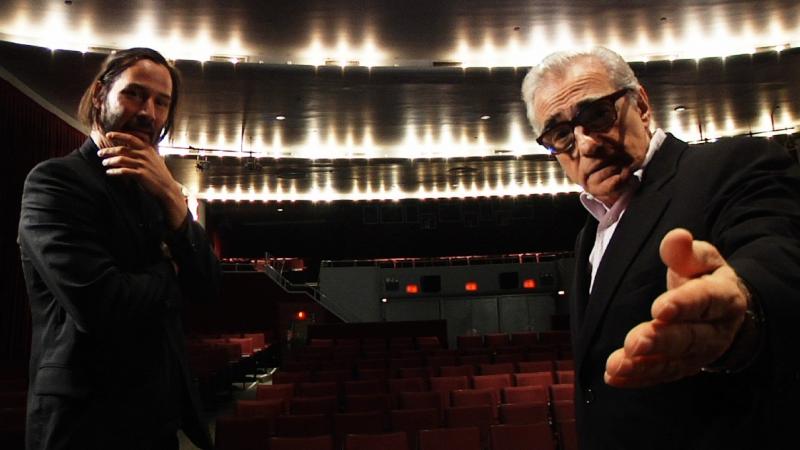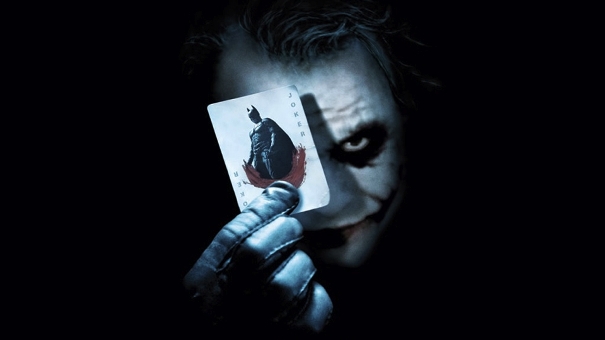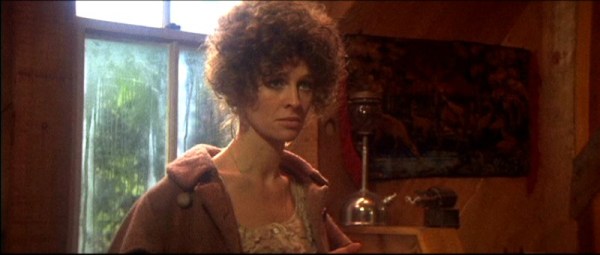Side by Side | reviews, news & interviews
Side by Side
Side by Side
Film vs. Digital? There's only one way to find out, says Keanu Reeves

Does it matter if film dies? Keanu Reeves, always cannier than his limited acting style suggests, produces and presents this even-handed documentary on analogue’s apparently fatal decline in the face of a very recent digital onslaught. His contact book brings enviable witnesses to the stand for director Chris Kenneally. If the world-famous directors and generations of legendary cinematographers don’t know the answer, maybe there isn’t one yet.
Side by Side is partly a manual in how films are made, the way in which light pours through camera apertures to create images, and the changes digital cameras have caused to that work. This new hardware has revolutionised film economics and, less obviously, on-set hierarchies. The power of the cinematographer’s camera to control images the director can only guess at till the rushes reveal all, is almost at an end. “They loved the voodoo of it,” David Fincher simmers of these celluloid priests, bemoaning the times when they “betrayed” his intentions. Martin Scorsese, whose recent work shows the strain of a director trying to keep up, misses the contemplative gap between shooting and viewing rushes allowed. A reduction in the waiting around so fundamental to film-making alters acting, too. Fincher recalls Robert Downey Jr. pissing in jars as a dirty protest as a shoot dragged on. Reeves, though, lets his A Scanner Darkly director Richard Linklater know that the sudden absence of pauses for reel-changes shattered him. Such hands-on familiarity makes Reeves a valuable, enthusiastic interviewer.
 Guerrilla-minded directors such as Steven Soderbergh and Robert Rodriguez are delighted at the independence and power digital equipment gives them. Soderbergh’s Che couldn’t have been made on its budget without lightweight digital cameras to penetrate tropical locations. Danny Boyle and Dod Mantle legitimised this technology and began its swift triumph in Slumdog Millionaire. Asked for the advantages of film, Soderbergh spits: “There are none. I hate it.”
Guerrilla-minded directors such as Steven Soderbergh and Robert Rodriguez are delighted at the independence and power digital equipment gives them. Soderbergh’s Che couldn’t have been made on its budget without lightweight digital cameras to penetrate tropical locations. Danny Boyle and Dod Mantle legitimised this technology and began its swift triumph in Slumdog Millionaire. Asked for the advantages of film, Soderbergh spits: “There are none. I hate it.”
Counter-arguments by Christopher Nolan and his cinematopher Walter Pfister insist the resolution and sensually subtle colour spectrum of 35mm is vastly superior to any digital alternative, meaning The Dark Knight trilogy (with Heath Ledger, pictured above) remained analogue. George Lucas brushes this aside, saying film is at its optimum, and the digital future will inevitably plough past it. Digital technology “doubles in everything” every two years. Anyone who strained their eyes at The Hobbit’s 48 frames-per-second 3D might well ask: why? But few are. When Paul Thomas Anderson’s The Master premiered with a London run in 35mm last year, it was the ceremonial indulgence of an art-house King Canute, not meaningful resistance.
 Film, the defining medium of 20th century modernity, is at the moment of its apparent passing valued for its naturalness. Taxi Driver cameraman Michael Chapman says they were “bringing emotion into the light”. The grains in film move; digital is fixed. In the last year I’ve felt the contrast between the richly textured reels of Robert Altman’s McCabe and Mrs. Miller (pictured above) breaking at the NFT and being swiftly respliced by trained projectionists, and the chilly, helpless pause when the digital connection crashes in a vacant projection booth.
Film, the defining medium of 20th century modernity, is at the moment of its apparent passing valued for its naturalness. Taxi Driver cameraman Michael Chapman says they were “bringing emotion into the light”. The grains in film move; digital is fixed. In the last year I’ve felt the contrast between the richly textured reels of Robert Altman’s McCabe and Mrs. Miller (pictured above) breaking at the NFT and being swiftly respliced by trained projectionists, and the chilly, helpless pause when the digital connection crashes in a vacant projection booth.
Film’s durability could yet save it. Digital technology is heedlessly advancing into a future where it may itself be displaced. Properly preserved cans of film remain the only reliable way to archive cinema. Open one, and its magic works with enduring simplicity. When the light passes through, the image lives.
rating
Buy
Explore topics
Share this article
The future of Arts Journalism
You can stop theartsdesk.com closing!
We urgently need financing to survive. Our fundraising drive has thus far raised £49,000 but we need to reach £100,000 or we will be forced to close. Please contribute here: https://gofund.me/c3f6033d
And if you can forward this information to anyone who might assist, we’d be grateful.

Subscribe to theartsdesk.com
Thank you for continuing to read our work on theartsdesk.com. For unlimited access to every article in its entirety, including our archive of more than 15,000 pieces, we're asking for £5 per month or £40 per year. We feel it's a very good deal, and hope you do too.
To take a subscription now simply click here.
And if you're looking for that extra gift for a friend or family member, why not treat them to a theartsdesk.com gift subscription?
more Film
 Blu-ray: Wendy and Lucy
Down-and-out in rural Oregon: Kelly Reichardt's third feature packs a huge punch
Blu-ray: Wendy and Lucy
Down-and-out in rural Oregon: Kelly Reichardt's third feature packs a huge punch
 The Mastermind review - another slim but nourishing slice of Americana from Kelly Reichardt
Josh O'Connor is perfect casting as a cocky middle-class American adrift in the 1970s
The Mastermind review - another slim but nourishing slice of Americana from Kelly Reichardt
Josh O'Connor is perfect casting as a cocky middle-class American adrift in the 1970s
 Springsteen: Deliver Me From Nowhere review - the story of the Boss who isn't boss of his own head
A brooding trip on the Bruce Springsteen highway of hard knocks
Springsteen: Deliver Me From Nowhere review - the story of the Boss who isn't boss of his own head
A brooding trip on the Bruce Springsteen highway of hard knocks
 The Perfect Neighbor, Netflix review - Florida found-footage documentary is a harrowing watch
Sundance winner chronicles a death that should have been prevented
The Perfect Neighbor, Netflix review - Florida found-footage documentary is a harrowing watch
Sundance winner chronicles a death that should have been prevented
 Blu-ray: Le Quai des Brumes
Love twinkles in the gloom of Marcel Carné’s fogbound French poetic realist classic
Blu-ray: Le Quai des Brumes
Love twinkles in the gloom of Marcel Carné’s fogbound French poetic realist classic
 Frankenstein review - the Prometheus of the charnel house
Guillermo del Toro is fitfully inspired, but often lost in long-held ambitions
Frankenstein review - the Prometheus of the charnel house
Guillermo del Toro is fitfully inspired, but often lost in long-held ambitions
 London Film Festival 2025 - a Korean masterclass in black comedy and a Camus classic effectively realised
New films from Park Chan-wook, Gianfranco Rosi, François Ozon, Ildikó Enyedi and more
London Film Festival 2025 - a Korean masterclass in black comedy and a Camus classic effectively realised
New films from Park Chan-wook, Gianfranco Rosi, François Ozon, Ildikó Enyedi and more
 After the Hunt review - muddled #MeToo provocation
Julia Roberts excels despite misfiring drama
After the Hunt review - muddled #MeToo provocation
Julia Roberts excels despite misfiring drama
 London Film Festival 2025 - Bradley Cooper channels John Bishop, the Boss goes to Nebraska, and a French pandemic
... not to mention Kristen Stewart's directing debut and a punchy prison drama
London Film Festival 2025 - Bradley Cooper channels John Bishop, the Boss goes to Nebraska, and a French pandemic
... not to mention Kristen Stewart's directing debut and a punchy prison drama
 Ballad of a Small Player review - Colin Farrell's all in as a gambler down on his luck
Conclave director Edward Berger swaps the Vatican for Asia's sin city
Ballad of a Small Player review - Colin Farrell's all in as a gambler down on his luck
Conclave director Edward Berger swaps the Vatican for Asia's sin city
 London Film Festival 2025 - from paranoia in Brazil and Iran, to light relief in New York and Tuscany
'Jay Kelly' disappoints, 'It Was Just an Accident' doesn't
London Film Festival 2025 - from paranoia in Brazil and Iran, to light relief in New York and Tuscany
'Jay Kelly' disappoints, 'It Was Just an Accident' doesn't
 Iron Ladies review - working-class heroines of the Miners' Strike
Documentary salutes the staunch women who fought Thatcher's pit closures
Iron Ladies review - working-class heroines of the Miners' Strike
Documentary salutes the staunch women who fought Thatcher's pit closures

Add comment